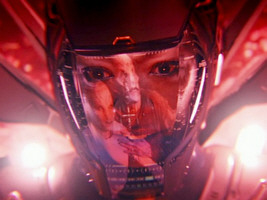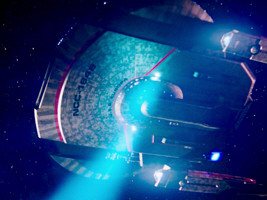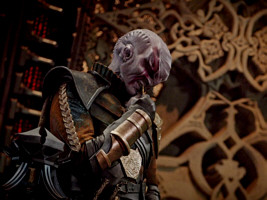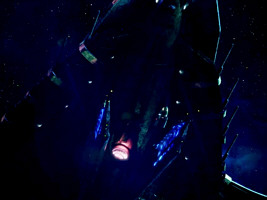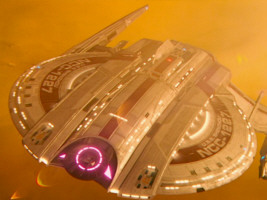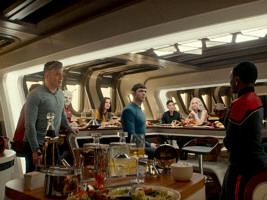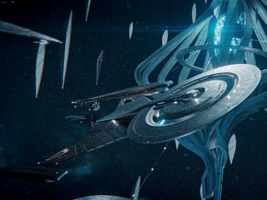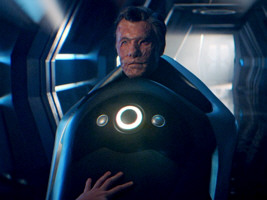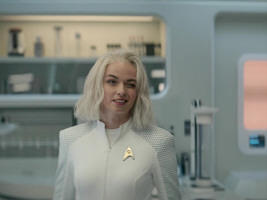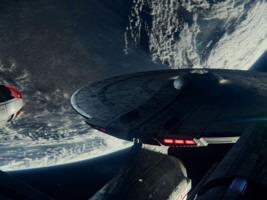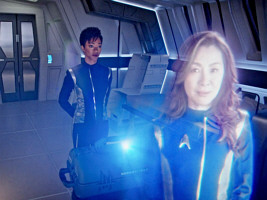Discoverse FAQ
 This special FAQ serves to explain the EAS site policy on the controversial series Star Trek Discovery and its spin-off Star Trek: Strange New Worlds. As such, it does not only respond to actual questions but also to frequent criticism of EAS regarding "Discoverse" issues.
This special FAQ serves to explain the EAS site policy on the controversial series Star Trek Discovery and its spin-off Star Trek: Strange New Worlds. As such, it does not only respond to actual questions but also to frequent criticism of EAS regarding "Discoverse" issues.
Q: I have been following your various comments on Discovery and SNW and your episode reviews. I personally see no major continuity problems with these two series and I enjoy the visual updates, but I can see where you come from.
A: This is not really a question, but an example of a civilized discussion about the Discoverse, without the namecalling that is going on in many communities. I respect fans with other opinions on how Star Trek should look and feel like, and the least I expect from my opponents is that they try to understand that I have important reasons to criticize the concept, many stories, the technology level and most design decisions of Star Trek Discovery and Strange New Worlds.
Q: Stop using the derogatory abbreviation "DIS" for Discovery as a part of your miserable crusade. Everyone else refers to it as "DSC"! It's official!
A: While "DSC" may be production jargon, I have settled on "DIS" for the sake of consistency. I'm not a fan of military-style all-consonant short names that are hard to pronounce. Some 20 years ago EAS already set the standard of referring to Voyager as "VOY" instead of "VGR". Memory Alpha followed my example for Voyager, and beat me to it regarding Discovery. You probably wouldn't complain that an unsuspecting site like MA too uses "DIS", would you?
Q: Why are your weekly episode reviews of Discovery and SNW coming so slowly? Just as the articles about re-used props and other canon references in the two series? You only withhold this because you hate the new Trek.
A: You probably wouldn't believe it, but I have a life besides Star Trek. Watching the episode and writing a review takes a full eight-hour work day on average. Updating the whole site with every new bit of information may amount to another work day. There is no other choice but to postpone some of this work.
A: If you bothered to actually read my Discovery reviews, you would notice that the stories and the characters are in the focus. I complain about story elements or visual styles that I simply don't like, in the very same fashion as in any of my 600+ reviews of old Star Trek series. And I take the right to point out when the series doesn't live up to its own claim to respect canon, just as I criticized the canon violations of any prior Star Trek series. My criticism about all these aspects of the series is absolutely proportionate. You may also notice that many of my reviews of Discovery are positive or neutral. Since I have decided to keep out the fundamental mistakes of Discovery from my ratings, the series is on par with the first season of TNG. You can't possibly claim that my Discovery reviews are unfair. If anything, they are too benevolent considering that I would instinctively rank anything Discovery lower than TNG.
Q: Are Star Trek Discovery and Strange New Worlds canon?
A: They are canon by their very definition, as TV series set in the Star Trek Universe officially produced by CBS, the owner of the rights. The canon status is not something to be earned based on merits. Vice versa, an official series (or movie) that is badly produced or simply unpopular wouldn't lose its canon status.
Q: But you denied Discovery its canon status practically since the day it was announced!
A: That is a lie, as evidenced by my production blog. I never contested that Discovery is canon. I only call its self-concept into question, and increasingly since the truth about the new Klingons became obvious. If I was of the opinion that Discovery was non-canon anyway, I would not care for its lack of continuity!
A: It is a caveat. Just like the Abramsverse, Discovery and SNW introduce elements that clash with the established canon, and in many cases are even deliberately designed to be anti-canon. The spore drive, the omnipotent time travel suit as well as Michael Burnham don't exist in classic Star Trek, and the order to keep them under wraps in "Such Sweet Sorrow II" is more like a lame excuse for true continuity.
On the visual side, the totally new Klingons are the prime example. No matter how hard we may try to make sense of them, Discovery is a separate universe as far as the Klingons are concerned. Until they were revised in SNW, we were apparently expected to forget that Klingons ever looked different than in DIS. All members of the race of all eras in all other Trek series were either consistent, or could be explained with the retcon from ENT: "Divergence". DIS defied the canon Klingons and exclusively showed a "proprietary" race. The producers of the Discoverse series told us they respected canon, but this did not apply at all to visual canon facts. Discovery was a "visual reboot", although in a visual medium this term makes about as much sense as "a little bit pregnant". SNW performs a bit better in this regard, but inherits design decisions other than the Klingons and its whole continuity from Discovery.
Q: Something like "visual canon" never existed. Only facts are canon, aesthetics are not!A: Wrong. Visual canon is a firmly established standard in Star Trek. In TNG: "Relics", DS9: "Trials and Tribble-ations" and ENT: "In a Mirror, Darkly", the world of TOS was faithfully reconstructed, not denying its look in any way. In Star Trek, visual facts are facts on par or even more meaningful than script contents. We're talking about a TV series after all, not a radio drama or a novel! We're talking about a franchise that has evolved to an iconic and more or less consistent universe for decades, and not a forgotten series from the 1960's! Many visuals that the makers of Discovery and, sadly, many fans discard as "purely aesthetic" have story relevance. It is not a matter of aesthetics but a canon fact that Klingons underwent some metamorphosis, as evidenced by DS9: "Trials and Tribble-ations" and ENT: "Divergence". It is canon that older Starfleet ships have tubular nacelles, and newer ones have angular or pointed ones, because this, among many other differences, visually sets apart the eras. Without a visual distinction of "humanoid" vs. "more alien" species or of "old" vs. "new" ships, Star Trek would become arbitrary, and stories wouldn't work any longer. Or stories would only work within its respective reboot universe.
Q: Here is a challenge. List the visual canon violations of Discovery and SNW, discounting everything that is of purely aesthetic nature!
A: We'd have to lay down the criteria first. I would have been fine with retcons that add realism, such as adding thrusters and visible torpedo/phaser ports to the original Enterprise design while keeping all proportions the same (meaning, not the complete redesign as in SNW). I am fine with visual updates/retcons that reflect real-world developments, such as the flatscreens on NX-01 and the transparent displays on the Discovery (although the latter are impractical). I am fine with make-up updates, such as the more elaborate and moving antennae of the ENT Andorians. I am fine with improved visual effects, such as better defined phaser beams, as long as they are still continuous. I am fine with an updated finish for personal equipment.
If we exclude the above, we still have the following visual canon issues (among others).
- It is canon that Klingons always have hair, irrespective of whether they are at war or at peace (with the sole exception of General Chang).
- It is canon that Klingons don't have pointed ears, because in TNG: "Birthright II" it sets apart the half-Romulan Ba'el.
- It is canon that Klingons are sexually rather more than less compatible with other species including human and Romulan. B'Elanna could not possibly exist in Discovery.
- It is canon that Klingons do not have elongated heads, and can pose as other humanoid species without being surgically mutilated, without "giving up everything".
- It is canon that Klingons exist in a more alien variation and in a more human one, due to the genetic treatment following the augment virus crisis, as seen in ENT: "Divergence".
- It is canon that no classic Tellarite that ever appeared had tusks.
- It is canon that Andorians and Aenar have eyebrows, never pointed bones above the eyes.
- It is canon that the D7 is a ship design with a distinct head and neck section, wings and nacelles. It is canon that a Bird-of-Prey is a small ship with moving wings, and not a capital ship.
- It is canon that Starfleet ships consist of decks that are packed with machinery, supplies and living spaces and don't include huge empty spaces, much less are they bigger on the inside than on the outside.
- It is canon that the Shenzhou has all the defining design features of late 24th century ships (so many and so prominent that it's more than a matter of aesthetics, unless we are content with a concept of a "generic one-era-fits-all Starfleet style saucer+nacelles vessel"). I am not allowed to simply reverse this statement, so strictly speaking the Discovery Starfleet designs are "only" an anachronism.
- It is canon that the original Constitution class bridge has no corridor behind the aft consoles and no second exit (which was amended for SNW, though).
- It is canon that Starfleet ships don't have bridge windows. (Since 2009, all Starfleet ships of all eras have bridge windows.)
- It is canon that the original Enterprise doesn't have a "Ten Forward" lounge with large panoramic windows.
A: The previous change to the Klingons was smaller than the current one. But even more importantly, it was explained in ENT: "Divergence" and hence does not constitute a reboot. Some fans may not like this retcon, but it was a consequence of Star Trek's policy (until 2017) that visuals were canon.
Q: The Discovery Klingons are not much different than the TMP/TNG-style Klingons, they only lacked the hair in season 1.
A: Denial doesn't help. Almost every aspect about the Klingon make-up/anatomy was altered. Almost every aspect about their culture and style was altered. It goes very far beyond an aesthetic change.
Q: Klingons have hair again in season 2 because traditionally they grow it back after a war. That perfectly explains all discrepancies.
A: The Klingons with hair (and other revisions to the revised make-up) are just a visual bridge to the ones of TMP. One of many problems of Discovery is alleviated. But we have to wonder why we never saw any bald Klingons (with the sole exception of Chang) in any era before and after DIS. The baldness can't be a tradition if it happens in just one era (and paradoxically in one where the Klingons are explicitly said to be very divided).
Q: The Discovery Klingons are much more alien and much more impressive than those retarded space Vikings of the past few decades.
A: That's just your opinion. It has no bearing at all on continuity. The Klingons as we know them since TMP are among the most important staples of Star Trek. There is no sense in arguing with you. I only find it sad how the production design of Discovery spoils the fans and gives rise to such depreciatory views of the classic Star Trek. Interestingly, the makers of DIS themselves recognized their error and made the Klingons more relatable again. And finally they even made a 180 degree turn and brought back classic Klingons in SNW: "The Broken Circle".
A: They are a big deal because they are much more significant than ever before, and because they are system inherent now. So far in Star Trek, inconsistencies mostly came to pass because of negligence, lacking time or limited budget. Aside from the Klingon metamorphosis between TOS and TMP, almost nothing was ever altered with the explicit idea that it is more than a visual update. For instance, the Klingon K't'inga class in the same movie is essentially a more detailed version of the D7 from TOS, with only slightly changed dimensions. In Discovery, a lot of work and money was invested in a new look that definitely isn't radically different by accident. Discovery Klingons don't resemble Klingons any longer, and their ships were totally altered as well. From all we can tell, the makers of Discovery want to force us to ignore these differences. They are not eligible for retcons. A dramatic paradigm shift. That is why I don't even try to explain them.
Q: But you explained away so many inconsistencies in Star Trek, with a good deal of conjecture.
A: That's not true. EAS shuns conjecture ("fanwank"). EAS will never try to resolve the canon errors of Discovery, unless the series itself comes up with an according retcon, or provides further evidence or at least clues. The backpedaling to give Klingons hair again and the attempt to justify several of the anti-canon facts of the series as "classified" ("Lex Spock") was a start. The return of classic Klingons is a next step. But I don't expect (and probably don't even want) everything to be rectified or explained.
Q: Discovery and SNW need the visual changes because Star Trek has to keep up with real-world technical developments.
A: Yes, as far as display technologies and user interfaces are concerned that definitely shouldn't look like in the 1960's. Yes, as far as make-up techniques are concerned, such as the moving antennae of the Andorians in ENT. Yes, as far as visual effects are concerned that may appear as more realistic with modern CGI. Yes, as far as merely aesthetic changes to designs are concerned, especially if they add realism, such as (hypothetically) visible hull plates and other details on an otherwise unaltered original Enterprise. The actual changes in DIS and SNW, however, go far beyond this acceptable range. Displays are overblown, Klingons were originally unrecognizable, visual effects are cartoonish, starship designs including the Enterprise are anachronistic and much too big. All these alterations are not rooted in real-world progress but in the desire to redesign Star Trek to something it never was.
Q: What you want is a Star Trek Museum, in which everything is exactly like in the 1960's, with sets that look like cardboard, and with Fu Manchu-style Klingons.
A: As I mentioned in the preceding answer, I would have been fine with a range of visual updates in Discovery. I totally acknowledge that Star Trek shouldn't look like a series made in the 1960's. People like you frequently resort to this strawman, and I'm sick of it, especially since my true stance on the topic is well-documented.
A: I agree that the design of the Shenzhou looks okay. And totally credible next to the Sovereign class. It could have been used for Star Trek Picard. But 23rd century? No way! The ship has all the typical design features of the 24th century, and none of the 23rd century, except perhaps the deflector dish. The Shenzhou is symptomatic of an attitude in the production design of Discovery that most elements (if they were not altered beyond recognition anyway, like the Klingons) are nothing more than "generic" and "undated" Star Trek. The lines of the Shenzhou were ripped from another era, its bridge windows from another universe. And it was scaled to an unreasonable length of well over 400m. Q: Can't you just let the people in charge make a new series without complaining about ship sizes once again?
A: No, if the people in charge ignore the well-documented scales. The sizes of the recent ships in the Abramsverse, Discovery and SNW are not determined by continuity and common sense any longer, but by the desire to create bombastic visual effects and fit in unrealistically spacious sets. Cadet Tilly's quarters on the Discovery is much bigger than Captain Kirk's on the original Enterprise! And Captain Pike's luxury suite on the reimagined ship appears to be ten times the size! Every single Starfleet ship of Discovery would dwarf the original Enterprise. A well-established continuity of more than 40 years is abandoned for the sake of showing off.
Q: You complain so much about the Klingons or the starships in Discovery. Why not about the wrong Starfleet uniforms and the unwarranted universal use of the arrowhead symbol on all ships?
A: It's generally not such a big deal if uniforms keep changing. It would have been a nice nod if the style of the Discovery uniforms had been reminiscent of "The Cage". And for what it's worth, even Discovery's very own uniforms are anything but consistent (the "new" uniforms of DIS: "Brother" also appear several years earlier in SHO: "Q&A"), and Strange New Worlds adds yet another variation that should not exist. Regarding the arrowhead symbol, there is a good (albeit not completely satisfactory) rationale that it may indeed represent the whole of Starfleet, rather than only the Enterprise.
Q: Why do you complain so much about the setting of Discovery and Strange New Worlds in the 23rd century? It's the stories that matter, not the looks and not your nostalgic idea that everything has to be preserved.
A: Sorry, but I am not the one who is nostalgic! I firmly believe that Star Trek has to move on and boldly go where no series has gone before. This simply doesn't work in a prequel like Enterprise, much less in a reboot. But almost all of Star Trek's latest live-action iterations (ENT, Abrams films, DIS and SNW) belong into these two categories of derivative settings (while Picard is extremely nostalgic in its third season for different reasons). I suppose the studio bosses think of Star Trek as an outdated science fiction show that has to be retold with modernized visuals, rather than as a living franchise that waits to be continued. Considering that Kirk, Spock and the Enterprise were already taken by the Abrams films, the setting of Discovery is the closest possible to a TOS reboot, and Strange New Worlds ventures even further in the direction of a "better TOS". Discovery's setting may not have been the first choice of the producers (Bryan Fuller purportedly wanted to create an anthology, rather than a prequel/reimagination). But I find it ironic how the makers of this series (as well as SNW's Akiva Goldsman) keep lamenting the limitations imposed on them by the established canon. Ironic because they don't respect crucial parts of the canon anyway, whereas they seem to be obsessed with getting their favorite tiny details right, in a textbook case of a cherry picking fallacy. Ultimately, concept and stories of the first two seasons of Discovery would work a lot better if it were set in the future, such as in the 25th century. Discovery would just have to get rid of all the gratuitous nostalgia. Sarek could be replaced with any other Vulcan, the Klingons could be any other race. Discovery could have started with a clean slate, without harming the established continuity, without questionable design decisions, with more story options and, perhaps most importantly, without splitting the fan base!
Q: 24th century Star Trek is exhausted after 15 years of TNG/DS9/VOY, and spoiled by the many new technologies introduced especially on Voyager. It was logical to go back in time for that matter.
A: I couldn't agree less. The exact opposite is true. Star Trek would have needed to move on, to go to the future, for all reasons mentioned in the answer above. If you resort to a prequel/reboot in a franchise once, you may find new ways. Do it twice, and you prove that you're clueless. Do it for a third time, and you kill the franchise. Create a spin-off (SNW) of the third series, and you beat a dead horse.
Q: Why do you still complain about the spore drive, time travel suit, Control and other alleged inconsistencies with TOS? The season 2 finale explained everything.
A: No one is to talk about all those things and people again, under penalty of treason. Yeah right. That is neither realistic, considering that thousands of people must know the technologies, the events or the people that are now classified (which makes the Moon landing hoax theory plausible by comparison), nor is it desirable for the Federation to be a totalitarian system that first puts their citizens into extreme danger and then lies to them about what has happened.
A: The radical change of the setting does not undo the damage the series inflicted in its first two seasons. But with the exception of the still existing spore drive, there are only occasional small canon issues. Discovery still isn't a great series but it has become watchable in its seasons 3, 4 and 5.
Q: It is obvious that Discovery is set in the Kelvin Timeline - because of the ships, the style, the general tone.
A: While the producers tell us a lot of things about the series that are not entirely true, the appearance of a ship that is supposed to be the TOS Enterprise and a of character that is supposed to be the TOS Spock, plus the depiction of Pike's fate, plus the "explanation" in the season 2 finale for the technology being different than in TOS, unmistakably place Discovery (and even more so SNW) in the Prime Universe.
Q: Don't you know Discovery is made under an alternative license and has to be 25% different than classic Trek for legal reasons?
A: Discovery looks the way it does (and in many cases, much more than 25% different) because that's what the people in charge wanted, to leave their artistic footprint and to better the established canon Trek. The alleged impediment by a "25% rule" loses credibility with every new season of Star Trek that is produced.
A: This stance is hard to uphold after the DIS season 2 finale and with the many continuity ties forged in SNW. Just as the relationship between the Abramsverse and the old Star Trek was nailed down as soon as in "Star Trek (2009)" (and ultimately in DIS: "Terra Prime I") as being two different timelines, "Through the Valley of Shadows", "Such Sweet Sorrow II" and "A Quality of Mercy" establish TOS and DIS/SNW as the same timeline. Since the claim that Discovery and SNW is Prime Universe canon is a far cry from reality, with regards to the history, the technology and the visuals, you may choose to abandon all canon ties and declare them a total reboot - but only in your headcanon.
Q: If you complain about Discovery and SNW's lacking adherence to canon, you are of one mind with the racist trolls who attack the diversity and inclusiveness of the series.
A: I don't know if I really have to respond to this preposterous incrimination. But this is an FAQ, so for the record, I can only affirm that I am absolutely positive about the character and casting choices of Discovery and SNW. I am glad that the two series reflects a modern view of the future, rather than one of the 1960's, in which it seemed like only white heterosexual men could be in the captain's chair. There is no correlation at all with my views on how the series should handle issues of (visual) canon.
Star Trek has always been about diversity. DIS and SNW are a consequential continuation in this regard. While the overwhelming majority of the fans agree with it, a few right-wing trolls blasted the casting choices for Discovery in 2017. Unfortunately, this incident was played up to a ridiculous extent in the media. I can't help the impression that, in the media and in a certain corner of the fandom, those hate posts are instrumentalized to give anyone a bad name who, like me, has justified issues with the idea of rebooting Trek.
Q: Wouldn't you agree that Strange New Worlds pays more respect to established canon than Discovery? Why still the "Discoverse" label?A: The designs, the technology level and the continuity of Strange New Worlds are essentially the same as in Discovery. There are some amendments, such as most notably the classic Klingons, but also the new uniforms and the reworked color scheme and interfaces of the reimagined Enterprise, which try to evoke the look of TOS. But the sheer size and capabilities of the ship are in stark contrast to TOS and to classic Trek on the whole. Also, characters are radically refined. For instance, Nurse Chapel mutates from a demure woman to a very cheeky person (or rather, the other way round in the chronology). No one wants to go back to the 1960's, but which of the two Chapels is canon? Overall, whereas Discovery tried out something totally new (and failed), SNW is like TOS redone the way that the producers think it should be for a modern audience. It definitely feels more like Star Trek than Discovery, but it is also more clearly a reboot.
Q: Why do you get so worked up about it? Sit back and enjoy the series.
A: Believe me, I would do that if I cared less for Star Trek as a whole and if I had not decided to run EAS, a site whose policy is to investigate Star Trek without glossing over its inconsistencies and without resorting to conjecture. But even without this burden, I still wouldn't think that Discovery a great series. If this were the first Star Trek I ever watched, it wouldn't get me hooked. At least, Strange New Worlds fares better so far.
Q: You say that Discovery and SNW ruin the old Star Trek. That's ridiculous. You can still take your VHS cassettes and immerse yourself in the bland world of Berman Trek.
A: The two series harm the old Star Trek in several metaphysical ways. They essentially demand from us to apply doublethink, to overlook visual discrepancies. It fortunately isn't the official position any longer, but it would have impaired my suspension of disbelief and my affection for the character to imagine Worf as a cumbersome bughead. Alex Kurtzman himself recognized the problem and made it clear that Worf would remain Worf, well before he actually returned in PIC season 3 and before classic Klingons showed up in SNW. In spite of this course correction, it still diminishes the perceived value of the old Star Trek that many of its assets such as the design of the original Enterprise are labeled as obsolete, by the producers of Discovery and SNW as well as by a certain faction of fans. As much as some people complain that "haters" like me put down Discovery, I can say the same about those who feel encouraged by Discovery to rant about the allegedly crappy production values of the TNG era. Finally, fanwank is a growing nuisance, especially if it involves re-interpretations of facts firmly established in the old Star Trek series, to make it fit with the new styles and new dogmas. I don't want to be compelled to rewatch the old series with the obligation to find clues to make sense of something that was never meant to make sense.
Q: EAS used to be great resource for all things Star Trek. But since the Abrams movies, you focus on putting down new productions. I can't stand all your negativity any longer.
A: That is not true. Your criticism sounds like EAS is an Anti-Abrams and Anti-Discovery site. You have a problem with a small percentage of EAS that is actually judgmental. Conversely, you fail to recognize that I criticize the errors of the "old" Star Trek series just as well. I may not have written essays on the canon issues of TMP or TNG because the site didn't yet exist when they were released, and also because the problems are very small compared to the Abramsverse or Discoverse. It is proportionate to comment on errors in other Star Trek series besides the big offenders in single paragraphs.
A: EAS is neither a Star Trek database where I simply list all things Star Trek, nor is it a work of fan fiction that fills all kinds of gaps or explains inconsistencies with fanwank. EAS is a site that cherishes the continuity of a 40-year legacy (well, and of a few things in the years that followed). Not everything in the franchise makes perfect sense, not everything was even designed to fit together in the first place. But it is worth looking at matters such as the Klingon Forehead Problem, even and especially since the retcon in Enterprise. It is an interesting subject to investigate how Starfleet's ships evolved from the 22nd to the 24th century and beyond. This is no longer possible in this form with the new evidence from the Abrams movies and especially from the Discoverse. Many of these facts, also and especially on the visual side, are designed to be in stark contradiction to established canon - not by accident but by choice. Considerations of how the Discovery Klingons, their ships, their style and their traditions could fit in are futile. The Federation ship design lineage would be ruined, once I tried to include the 24th century design of the Shenzhou as a 23rd century ship, or if I even tried to pretend that the original Enterprise and its DIS/SNW reimagination were identical. Believe it or not, I would indeed jeopardize my website (or my sanity) once I treated Discovery and SNW the same way as any other canon Trek series. And so I have to define workarounds for them, in order to preserve the long-standing standards for the rest and to be able to carry on at all. For the sake of transparency and to demonstrate that it is a lot more than a gut feeling, I take the pain of explaining these standards in detail, even though I am aware that in the eyes of some people this creates even more an impression that my view of the Discoverse is unfair.
Q: You're such a loser. All other fans and all other Star Trek websites are full of praise for Discovery and SNW and embrace the visual changes made for the series.
A: Since my views are unpopular, does it make them wrong or not worth listening to? Is good Star Trek solely a matter of a majority vote? I know there are countless fans like me, who are put off by the lack of respect for the existing Star Trek. But I also know that many of the critical fans prefer to remain silent because "haters" are given a hard time by "loyal fans". Case in point: Some website lists "10 canon Easter eggs in Discovery" and that site, as well as Discovery, get unanimous praise for their attention to detail. EAS lists "10 continuity issues of Discovery", and a self-righteous crowd puts me on a witch trial for my blasphemy.
A: I am aware that DS9 had a much longer war and more dark stories in terms of episode runtime. But DS9 was firmly embedded into the overall optimistic world of the 24th century, whereas Discovery rewrites the 23rd century to a dark era, both in season 1 and season 2. Season 1 was desolate because after the death of Captain Georgiou, Michael Burnham was on her own to uphold the principles of the Federation, even against Sarek! Season 2 added Pike and Spock as two other positive characters, but once again Starfleet/Section 31 had a dark agenda. Do the war with the Klingons and the conflict with Section 31 with their missing opportunities to show a peaceful spirit and a positive vision of the future exonerate Discovery? Is it sufficient for the producers to evoke the legacy of Star Trek in interviews, without actually continuing it in the series? Is it so important for Discovery to be "modern" and to comment on the sad state of our present world that it doesn't show a bright future any longer?
Q: Don't you agree that The Orville is the better Star Trek? Are you going to review it?
A: A definite no on both questions. The Orville is clearly more like the old Star Trek series regarding the stories, the visuals and the overall optimistic atmosphere. I do like it better than Discovery, but it is not set in the Star Trek universe. I am not going to review The Orville because EAS is about Star Trek, and everything off-topic would only distract from the goals of my site.






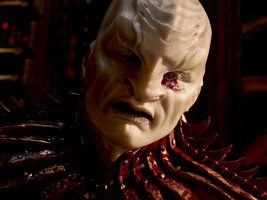
 Voq in DIS: "Battle at the Binary Stars"
Voq in DIS: "Battle at the Binary Stars"